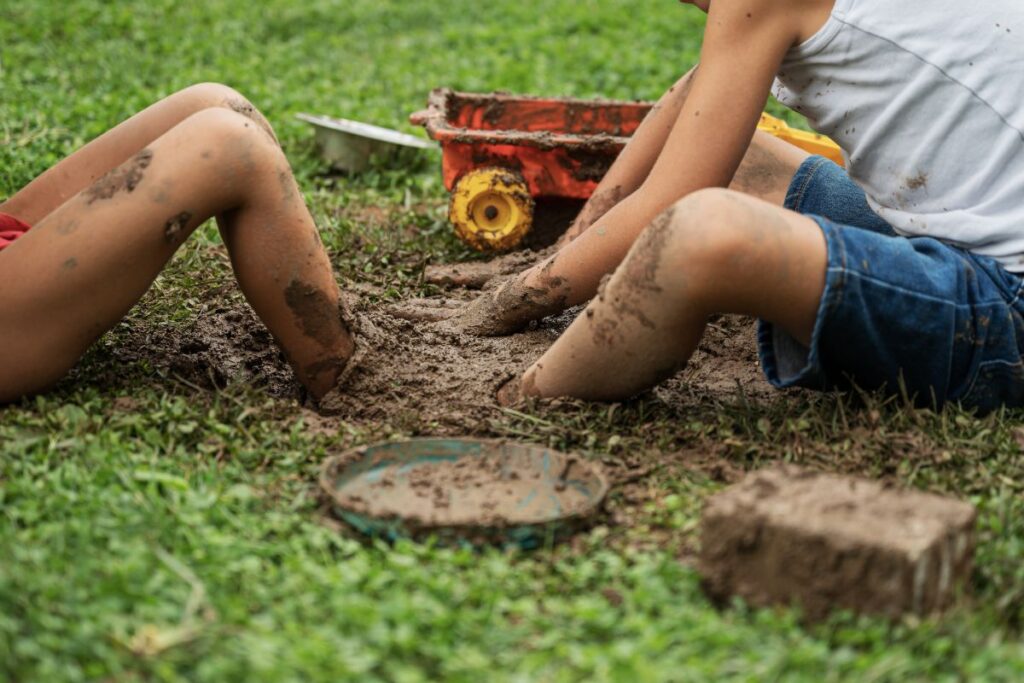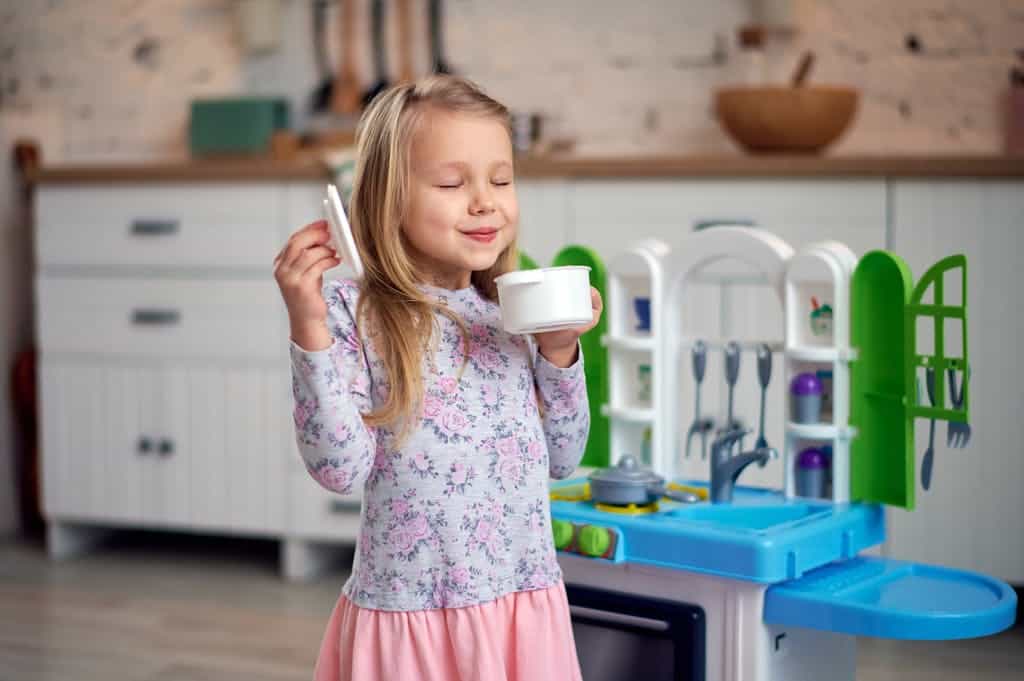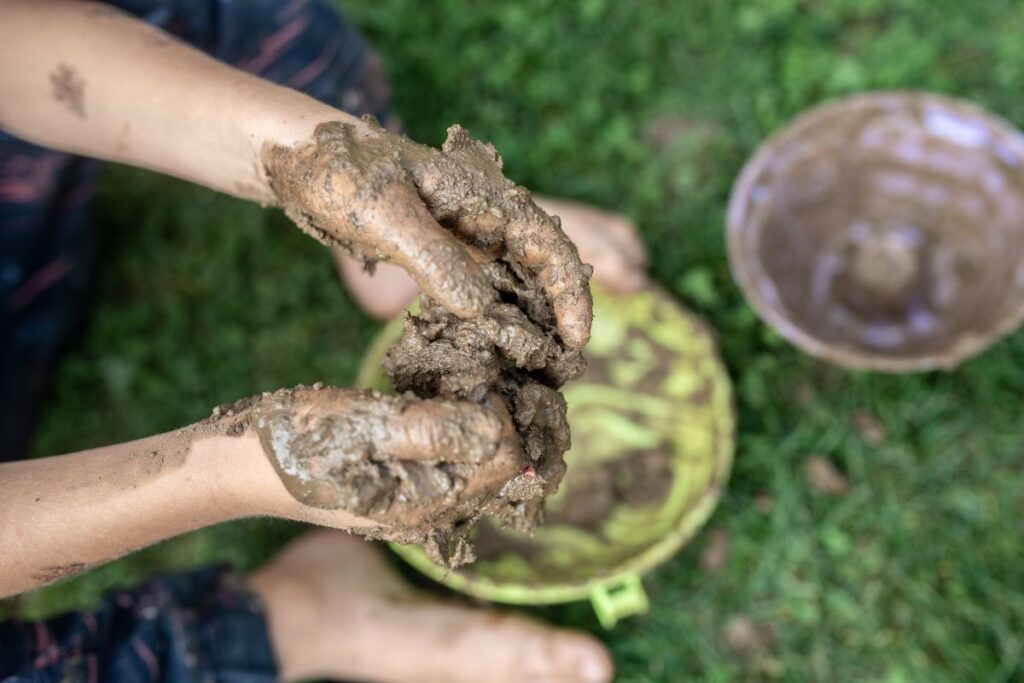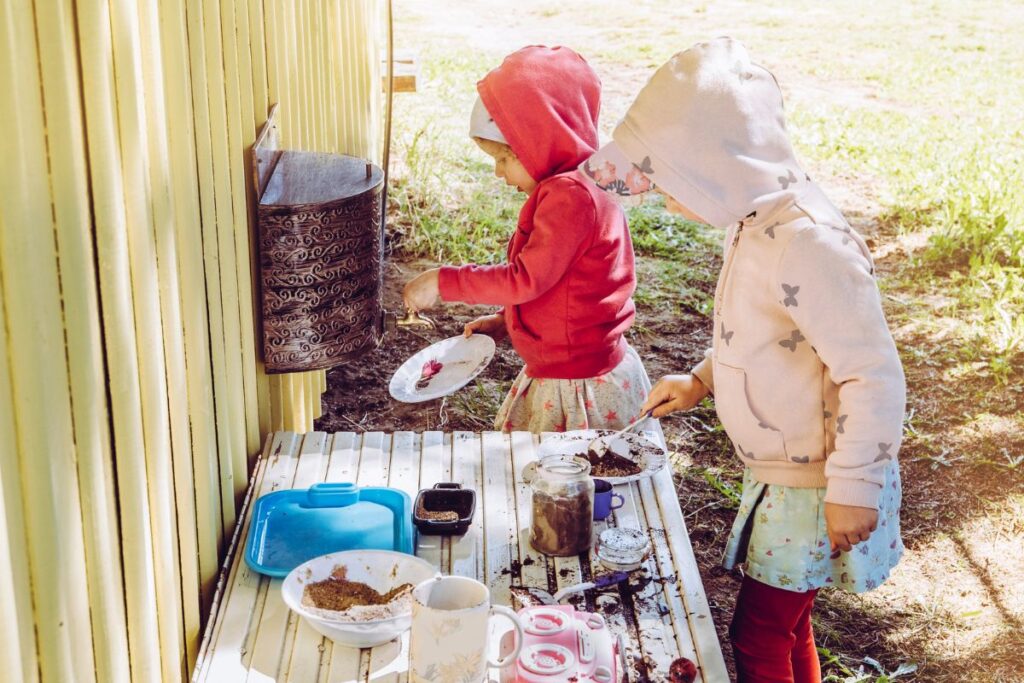The Best Soil for Mud Play [and why mud play matters]
Playing in the mud is a favorite pastime for many children. It's also important for development and learning, as it helps them explore their environment and build sensory skills.
Play. Learn. Thrive.™ only endorses products we authentically love and use. Some of the product links in this post may be affiliate links. That means that if you click them and make a purchase, this site makes a commission. Play. Learn. Thrive.™ is also an Amazon Associate. As an Amazon Associate, we earn from qualifying purchases. It will have no impact on the price you pay or the experience of your purchase.
Different soil types have different properties that can affect how much fun your little one has playing with dirt.
In this article, we'll discuss the best soil for mud play, the overall benefits of mud play, and how to prepare your space (and mindset) for mud play.

Types of Soil for Mud Play
Mud play is a great way for parents to engage with their children and help them learn through tactile exploration. Choosing the right soil type for mud play is important, as different soils have different properties that can affect the experience. Clay, sandy, and loam are common soil types for mud play.
They are all good in their own ways, so honestly, as long as the soil in your yard is clean, that's the best type for you to use, as it's free!
Clay Soil:
Clay is made up of very small particles that form a thick paste when wet. It is ideal for making castles and other shapes in mud play because it holds its shape well when dry. The downside to clay is that it can be difficult to clean off clothing or skin afterward due to its sticky nature. Making cleanup a little more tedious.
Sandy Soil:
Sandy soil consists mostly of larger particles, making it easier to clean off after use than clay but also less malleable while playing in the mud. Sand is great for building sandcastles or digging trenches as it will hold its shape more easily than clay when wet and won't stick as much once dried out again.
Loam soil:
Loam soil is a combination of both clay and sandy soils. Loam holds moisture better than sand, so you won't need to replenish the water as often during playtime. Plus, unlike clay, loam doesn't become overly sticky when wetted – making post-play cleanup a breeze.
If you're looking for soil more resilient to wet weather, loam could be the ideal choice – particularly if your area experiences heavy rainfall or flooding.

50 Simple Screen-Free Learning Activities for Curious Kids
These 50 hands-on activities help children develop problem-solving skills, creativity, and real-world knowledge—without needing a screen. Designed to encourage self-directed play, hands-on discovery, and deep learning, this guide gives you a simple way to turn everyday moments into powerful learning opportunities.
Benefits of Mud Play
Mud play offers many benefits for children, from cognitive development to physical and social growth.
Cognitive Development:
Mud play encourages problem-solving skills as kids explore the properties of mud and create objects with it. It also helps develop fine motor skills as they manipulate the mud into shapes and forms.
Additionally, it can help build their vocabulary by introducing new words related to nature or science.
Finally, playing in the mud can improve concentration levels by providing an engaging sensory experience that allows them to focus on one task at a time.
Engaging in mud play activities not only strengthens physicality through digging. It also provides a natural avenue for kids to hone their gross motor skills through outdoor play; gross motor skills are things like running, leaping, climbing trees, and throwing- all of which are paramount for nurturing healthy bodies. Furthermore, research shows that coming into contact with dirt may even boost their immune systems, which is a serious win.
Mud play is great for promoting teamwork among peers since they often need each other’s help when building structures or making large sculptures out of clay or mud.
Mud play provides a variety of benefits to children, both cognitively and physically.

Preparing the Soil for Mud Play
Engaging in mud play can be an awesome experience for both kids and parents, but it's important to ensure that it is safe and enjoyable. That is a simple enough process as it's just about making sure the mud your child uses to play is not contaminated.
Also, it's a good idea to think about where in your yard or outdoor space the child will be playing with mud to make cleaning up easier for you.
Adding some natural materials like rocks, sticks, or leaves to your outdoor mud play area can be a great addition to encourage creativity.
Choosing the Right Location:
Look for areas with plenty of open space where children can move freely without any nearby obstructions or hazards. Avoid locations near stagnant bodies of water since these may contain materials like bacteria or algae. Additionally, make sure there aren’t any sharp objects in the vicinity that could injure kids while playing in the mud (this is especially important if you're in a public area)
If you want to really level up your mud play, consider adding a mud kitchen to your yard space. It's one of our absolute favorite places for mud play outside.
Adding Water and Mixing the Soil Together:
Once you have selected an appropriate location, consider adding water to the soil mix before allowing your child to play in it. Start by adding enough water so that when mixed together with the soil creates a wet but not too sloppy consistency – this will help keep messes at bay while still allowing kids to get creative with their building projects.
You can also add natural ingredients like leaves or twigs into the mix for added texture and interest if desired – ensure they are free from pesticides or other chemicals before introducing them into your kid's project.
It goes without saying that cleanliness should always be taken seriously. That said, clean mud is not likely to get your child sick. It's actually more likely to help them develop immunity as it exposes them to microorganisms that build up their immune systems to fight against illness.
Cleaning Up After Mud Play
Mud and dirt play can be an awesome way for children to develop and explore. However, it’s important to remember that cleaning up after mud play is as important as the fun you had during the activity. Once the fun of mud play has ended, it is essential to ensure a thorough cleanup so you don't end up with a house full of mud!
After your child has finished playing in the mud, it's time to get them cleaned up. First, remove any excess dirt or debris from clothing with a damp cloth or sponge.
If necessary, you can use soap and water on tougher stains. Gently wipe away any soil with a moist cloth or sponge, avoiding harsh scrubbing, before rinsing off with tepid water.
I usually have mine take off all their mud play clothes and hop straight into the shower so I don't have to deal with it!

FAQs about the Best Soil for Mud Play
What soil is best for mud play?
The best soil for mud play is loamy soil. Loam combines clay, sand, and silt particles that provide good drainage while holding moisture well. It also can hold nutrients that can help with plant growth if you plan on planting something in your mud pit or garden. Additionally, it's easy to work with since it compacts together nicely and won't become too muddy when to wet down properly.
What is the best soil for kids to play with?
The best soil for kids to play with is a combination of sand and loam. Sand helps create the right texture, while loam provides essential nutrients and minerals that promote healthy growth. Loam also has better water retention than other soils, making keeping moisture levels consistent during playtime easier. Children can manipulate the soil, providing a secure space to express their imagination. But keep in mind that the best soil is whatever soil you have access to as long as it's clean! There is no need to go out and buy soil unless you don't have access to clean soil at home.
Can kids play in topsoil used for gardening?
It's fine for children to play in topsoil as long as it doesn't add pesticides or other chemicals. If you are purchasing topsoil for your child to play in, make sure to ask that the soil doesn't add potentially harmful ingredients.
What is the best mud for a mud kitchen?
The perfect mud for a kitchen should be safe, malleable, and easy to clean up. Clay soil mixed with sand or compost creates an ideal texture that can be shaped and molded into different shapes. An ideal alternative to clay soil for a mud kitchen is topsoil mixed with water to create a thick paste. The mixture should be free of large stones or chunks as these could become choking hazards if ingested by children. When selecting your materials, make sure they are safe for kids. Read all about the benefits of having a mud kitchen here!
Mud play offers kids a stimulating and entertaining experience, enabling them to explore, discover and have fun. With the right soil type and preparation, it can be an enjoyable activity for children and parents.
By selecting the best soil for mud play, you'll ensure that your child has a safe environment to create their masterpieces while allowing them to engage with nature on a deeper level. So go ahead – get muddy.

